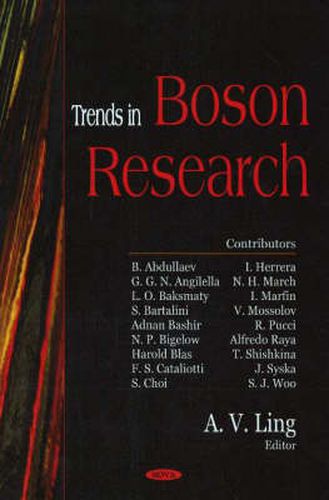Readings Newsletter
Become a Readings Member to make your shopping experience even easier.
Sign in or sign up for free!
You’re not far away from qualifying for FREE standard shipping within Australia
You’ve qualified for FREE standard shipping within Australia
The cart is loading…






Bosons are particles which form totally-symmetric composite quantum states. As a result, they obey Bose-Einstein statistics. The spin-statistics theorem states that bosons have integer spin. Bosons are also the only particles which can occupy the same state as another. All elementary particles are either bosons or fermions. Gauge bosons are elementary particles which act as the carriers of the fundamental forces such as the W vector bosons of the weak force, the gluons of the strong force, the photons of the electromagnetic force, and the graviton of the gravitational force. Particles composed of a number of other particles (such as protons or nuclei) can be either fermions or bosons, depending on their total spin. Hence, many nuclei are in fact bosons. While fermions obey the Pauli exclusion principle: no more than one fermion can occupy a single quantum state , there is no exclusion property for bosons, which are free to (and indeed, other things being equal, tend to) crowd into the same quantum state. This explains the spectrum of black-body radiation and the operation of lasers, the properties of superfluid helium-4 and the possibility of bosons to form Bose-Einstein condensates, a particular state of matter. It is important to note that, Bose-Einstein condensation occurs only at ultralow temperature. There is nothing exotic about bosons otherwise. At any reasonable temperatures, both the boson and fermion particles behave as classical particles, i.e. particle in a box, and follow the Maxwell-Boltzmann Statistics. This new book includes leading research from around the world.
$9.00 standard shipping within Australia
FREE standard shipping within Australia for orders over $100.00
Express & International shipping calculated at checkout
Bosons are particles which form totally-symmetric composite quantum states. As a result, they obey Bose-Einstein statistics. The spin-statistics theorem states that bosons have integer spin. Bosons are also the only particles which can occupy the same state as another. All elementary particles are either bosons or fermions. Gauge bosons are elementary particles which act as the carriers of the fundamental forces such as the W vector bosons of the weak force, the gluons of the strong force, the photons of the electromagnetic force, and the graviton of the gravitational force. Particles composed of a number of other particles (such as protons or nuclei) can be either fermions or bosons, depending on their total spin. Hence, many nuclei are in fact bosons. While fermions obey the Pauli exclusion principle: no more than one fermion can occupy a single quantum state , there is no exclusion property for bosons, which are free to (and indeed, other things being equal, tend to) crowd into the same quantum state. This explains the spectrum of black-body radiation and the operation of lasers, the properties of superfluid helium-4 and the possibility of bosons to form Bose-Einstein condensates, a particular state of matter. It is important to note that, Bose-Einstein condensation occurs only at ultralow temperature. There is nothing exotic about bosons otherwise. At any reasonable temperatures, both the boson and fermion particles behave as classical particles, i.e. particle in a box, and follow the Maxwell-Boltzmann Statistics. This new book includes leading research from around the world.